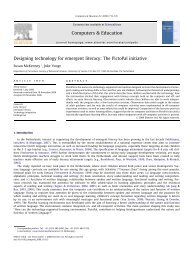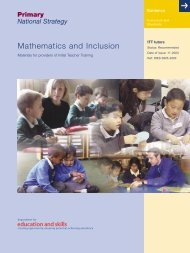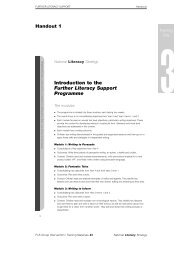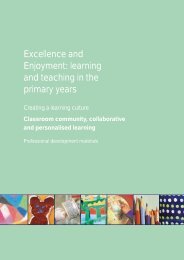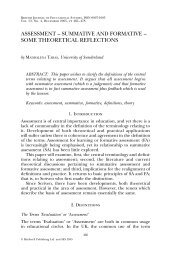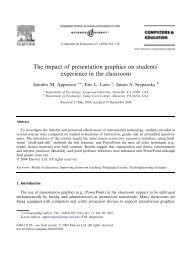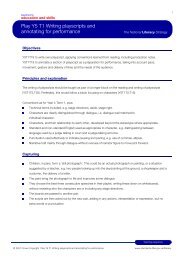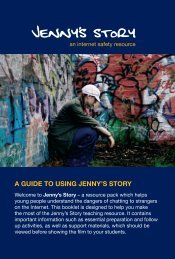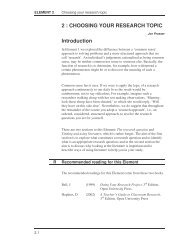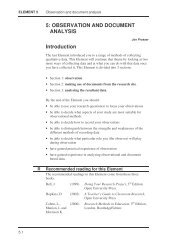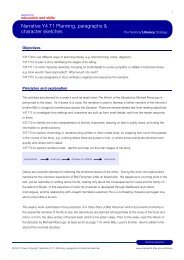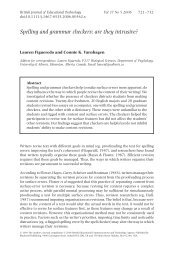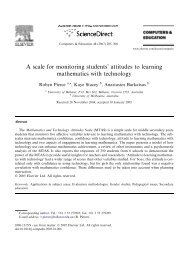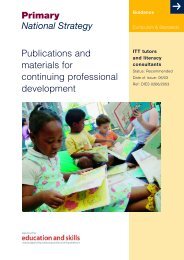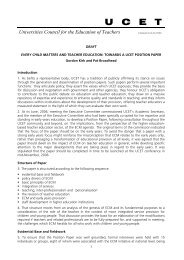Module 2: Written feedback - PGCE
Module 2: Written feedback - PGCE
Module 2: Written feedback - PGCE
Create successful ePaper yourself
Turn your PDF publications into a flip-book with our unique Google optimized e-Paper software.
Unit<br />
4<br />
<strong>Module</strong> 2: <strong>Written</strong> <strong>feedback</strong><br />
Objectives<br />
• To recognise the types of written <strong>feedback</strong> that best help pupils to improve<br />
• To focus written <strong>feedback</strong> on the learning objectives and planned learning<br />
outcomes of lessons so that pupils can see the immediate relevance of<br />
comments<br />
• To develop a strategy to provide written <strong>feedback</strong> that will better help<br />
pupils to improve<br />
• To contribute to developing a whole-school policy linking and clarifying the<br />
relationship between oral and written <strong>feedback</strong><br />
Resources<br />
Slides 4.2.1–4.2.8<br />
Handouts 4.2.1–4.2.5<br />
Session outline<br />
4.1 Introduction 10 minutes<br />
4.2 Developing written <strong>feedback</strong> 35 minutes<br />
4.3 Using written <strong>feedback</strong> 25 minutes<br />
4.4 Ready for more? 5 minutes<br />
Total<br />
75 minutes<br />
Pre-course task<br />
Participants need to select two pieces of pupils’ work from Years 7, 8 or 9 that<br />
they have recently marked.<br />
Each piece of work should have with it the learning objectives and the planned<br />
learning outcomes for the lesson.<br />
1 Unit 4, <strong>Module</strong> 2: <strong>Written</strong> <strong>feedback</strong> © Crown copyright 2004
4.1 Introduction 10 minutes<br />
Show slide 4.2.1.<br />
Slide 4.2.1<br />
You will find it helpful to remind participants of the introductory point made in<br />
module 1 of this unit, namely that modules 1 and 2 of this unit, ‘Oral <strong>feedback</strong>’<br />
and ‘<strong>Written</strong> <strong>feedback</strong>’, are closely interrelated. Both focus on improving the<br />
quality of regular constructive and informative <strong>feedback</strong> in order to help pupils<br />
take the next steps in their learning and make progress towards their targets.<br />
<strong>Module</strong> 2, ‘<strong>Written</strong> <strong>feedback</strong>’, focuses on providing high-quality, detailed and<br />
informative marking on a selective basis rather than cursory surface marking for<br />
all pupils on every piece of work. This will involve a significant change in marking<br />
policy for many departments and schools. This approach to providing written<br />
<strong>feedback</strong> cannot work unless oral <strong>feedback</strong> is detailed, personalised and<br />
routinely provides the information pupils need to make progress.<br />
The relationship between oral and written <strong>feedback</strong> needs to be agreed and<br />
embodied in the whole-school policy and must be explicitly shared with pupils<br />
and parents so that what pupils can expect to receive is clear. Schools must<br />
continue to ensure that approaches to providing <strong>feedback</strong> and its quality remain<br />
consistent across departments.<br />
Tell participants that research provides strong evidence to show how effective<br />
written <strong>feedback</strong> can promote learning.<br />
Show slide 4.2.2.<br />
Slide 4.2.2<br />
Say that these are the guiding principles for written <strong>feedback</strong> and will need to be<br />
borne in mind when formulating whole-school policy. Issues such as the<br />
appropriate amount and regularity of detailed <strong>feedback</strong> and the form and place<br />
of grades, marks and levels will also need to be agreed and applied consistently<br />
across the school.<br />
2 Whole-school development in assessment for learning | Presenter’s Notes © Crown copyright 2004
Show slide 4.2.3.<br />
Slide 4.2.3<br />
Explain the following.<br />
• Effective <strong>feedback</strong> depends on pupils being clear about what is expected of<br />
them and what they can expect from the teacher. Pupils should expect the<br />
<strong>feedback</strong> they receive to explain what they have done well with reasons, and<br />
where and how they can improve. Where this is the case they are more likely<br />
to engage with its content.<br />
• The learning objectives and learning outcomes should be used as the<br />
benchmark for the teacher’s oral and written <strong>feedback</strong>. They should be<br />
shared and made clear to pupils in advance of attempting the task. For<br />
example, if the learning outcome for the pupil is to be able to write a letter to<br />
a headteacher persuading him to agree to a school council, it is not<br />
appropriate for the <strong>feedback</strong> to concentrate simply on spelling and<br />
grammar – it should focus more on the use of appropriate conventions for<br />
persuasive writing in a formal context which will have been taught<br />
beforehand.<br />
• Pupils should be given written <strong>feedback</strong> that provides clear evaluation of<br />
their strengths and weaknesses, prompts further thought and reasoning,<br />
and identifies the next step in their learning.<br />
• To be able to identify the next steps in pupils’ learning, teachers need an<br />
understanding of subject progression and to be able to recognise pupils’<br />
misconceptions and difficulties.<br />
3 Unit 4, <strong>Module</strong> 2: <strong>Written</strong> <strong>feedback</strong> © Crown copyright 2004
4.2 Developing written <strong>feedback</strong> 35 minutes<br />
Introduce this section by displaying slide 4.2.4 to show some research findings<br />
into <strong>feedback</strong> and pupils’ response to it.<br />
Slide 4.2.4<br />
Explain the following.<br />
• Changing the way teachers provide written <strong>feedback</strong> to pupils, including<br />
the marking of their work, to make <strong>feedback</strong> more focused and selective<br />
requires teachers, pupils and parents to understand the rationale and<br />
the process.<br />
• Clear guidance needs to be agreed as to the regularity of detailed<br />
written <strong>feedback</strong> and departments need to identify the key pieces of work<br />
to focus upon.<br />
• The use of marks, grades and levels and how these are recorded and<br />
shared with parents need to be agreed at whole-school level.<br />
Task A (20 minutes)<br />
Tell participants the following.<br />
• The task involves looking at a range of teacher comments and suggesting<br />
whether they consider the <strong>feedback</strong> to the pupils to be helpful.<br />
• The participants are provided with handout 4.2.1 which gives:<br />
– a number of teacher comments;<br />
– some criteria to help participants judge the helpfulness of the comments<br />
to the pupils.<br />
Handout 4.2.1<br />
Handout 4.2.1<br />
Handout 4.2.1 cont.<br />
Teacher comment Does the <strong>feedback</strong> provide information to the pupil about:<br />
whether they are their limitations and a way to improve a way to think through<br />
on the right track? encourage them to their learning? the answer for<br />
correct work? themselves?<br />
You started off well. Unfortunately you have made the<br />
same error in the last three questions. Can you see<br />
what this is? You may find it helpful to go back to the<br />
grid method.<br />
Your poem about copper sulphate was interesting. We<br />
need to discuss how you think copper crystals are<br />
made.<br />
Attainment 3 Effort 2<br />
You have made good progress in your handwriting.<br />
Your spelling still needs work.<br />
I think we need to talk about this work in more detail.<br />
Yet again you have not completed the work.<br />
Well done Simon. This is a very impressive article<br />
about the pros and cons of nuclear power. It was well<br />
presented as a newspaper article and I liked your<br />
quotes from different members of the public.<br />
The concerns you started to raise about nuclear waste<br />
perhaps need some further discussion. We can talk<br />
about this next lesson.<br />
Teacher comment Does the <strong>feedback</strong> provide information to the pupil about:<br />
whether they are their limitations and a way to improve a way to think through<br />
on the right track? encourage them to their learning? the answer for<br />
correct work? themselves?<br />
Well done – 1 merit<br />
A good ‘best fit graph’. The conclusion clearly explains<br />
the relationship between the force and the extension<br />
of the spring.<br />
There are a lot of inaccuracies in this work. Please<br />
check it through again.<br />
This work shows you have clear understanding of<br />
finding the areas and perimeters. What strategies did<br />
you use to calculate the answers? What were<br />
the important steps for you?<br />
You’ve plotted some interesting shapes. Well done!<br />
You have included more adjectives, which help bring<br />
the character alive on the page, but your sentence<br />
structure is not as varied as John’s. Experiment more<br />
by using complex sentences.<br />
Cracking piece of work. I like the diagrams and the<br />
interesting way you presented the impact of man on<br />
the environment. Keep it up!<br />
• The criteria have been adapted for the task from the research findings<br />
highlighted at the start of the module.<br />
4 Whole-school development in assessment for learning | Presenter’s Notes © Crown copyright 2004
Ask participants to work in pairs. Allocate the examples between them<br />
according to numbers. Explain that they have 10 minutes for the task. It is not<br />
necessary to consider all the teacher comments in this time, but ensure variety.<br />
After 10 minutes take some <strong>feedback</strong> and use the key points on slide 4.2.5<br />
to summarise.<br />
Show slide 4.2.5.<br />
Slide 4.2.5<br />
Handout 4.2.2<br />
Ask participants to read handout 4.2.2 and briefly discuss with a partner and<br />
traffic-light those statements in terms of how they reflect their own practice (e.g.<br />
red – rarely, amber – often, green – typically).<br />
Make the following points.<br />
• It is important that <strong>feedback</strong> to pupils is related to their performance against<br />
the learning objective, not to the work of other pupils. If their performance is<br />
compared with that of other pupils it can lead to low self-esteem.<br />
• Pupils need to be shown they are on the right track. Comments like Your<br />
explanation about … is … are helpful.<br />
• Where pupils need to correct or develop their work it is important that the<br />
teacher provides the time for follow-up discussions and pupil action. A<br />
significant proportion of teacher comments in books say:<br />
– Complete this …<br />
– Re-draw the diagram!<br />
– Add in your ideas about …<br />
Rarely do pupils respond to these comments nor do the teachers check.<br />
Pupils can only respond to comments if they are given time to do so when<br />
the <strong>feedback</strong> the pupil has received is fresh in the mind.<br />
• Teachers should resist the temptation of giving the pupils the correct<br />
answers where there is a process that pupils can apply. In mathematics for<br />
example, it is easier to provide the answer to calculations rather than take<br />
pupils through the process of thinking the problem through.<br />
Continue by explaining the following.<br />
• Pupils often report that comments like try harder or be more logical are<br />
demoralising and do not match their own perception of the work. Such<br />
comments are often subjective. Focus on the specific learning objectives<br />
and outcomes.<br />
• Comments such as good work and well done or lots of ticks and merits may<br />
signify approval and can motivate pupils, but are not enough, as they do not<br />
5 Unit 4, <strong>Module</strong> 2: <strong>Written</strong> <strong>feedback</strong> © Crown copyright 2004
help the pupils bridge the gap between present performance and<br />
future targets.<br />
• Research shows that pupils and parents are frequently confused by effort<br />
and attainment grades. Grades encourage pupils to look for ways to get the<br />
best marks rather than find what they need to do to improve their learning.<br />
Effort grades are subjective and can engender feelings of injustice.<br />
• Pupils’ perception of what marks such as A+, C–, 5/10 mean is often<br />
different from what the teacher intended. This is because the mark scheme<br />
or criteria have not been sufficiently shared with the pupils.<br />
• Research on marking reported in Inside the black box: raising standards<br />
through classroom assessment (Black and Wiliam, 1998) indicates that<br />
giving marks to pupils can act as a disincentive. For example, pupils who<br />
receive 2/10 can be disillusioned and the mark can serve to reinforce their<br />
poor performance. Those pupils given 9/10 receive satisfaction but no<br />
incentive to keep improving.<br />
Task B (15 minutes)<br />
Ask participants to skim-read handout 4.2.3, Fiona’s work, in pairs. Tell them<br />
to note the structure – it includes:<br />
• the lesson objective;<br />
• differentiated pupil outcomes;<br />
• the work of one pupil (Fiona);<br />
• the teacher’s response.<br />
Handout 4.2.3<br />
Task B<br />
Handout 4.2.3<br />
Fiona’s work<br />
Handout 4.2.3 cont.<br />
The following example of work is from Fiona’s logbook. All pupils complete this type of logbook<br />
at the end of the week in Key Stage 3. Logbooks provide valuable information about what the<br />
pupils have learned. Some work is marked in detail as indicated below because these items<br />
have been identified as milestones in all pupils’ learning. The objectives are shared with pupils<br />
and the teacher uses the expected pupils’ outcomes to interact with pupils while they complete<br />
their logbooks. This can now be related to the yearly teaching objectives for Year 7.<br />
The lesson objectives are:<br />
To be able to use a simple particle model to explain:<br />
• why diffusion only occurs in liquids and gases;<br />
• what happens when air is heated in a can with a lid.<br />
(These are shared with pupils.)<br />
The expected pupils’ outcome is a way of showing how pupils of different ability may<br />
demonstrate their achievement.<br />
A Uses the correct terminology to describe the sequence of the process when:<br />
• two different gases diffuse;<br />
• air expands and pushes and releases the lid of the can.<br />
This is broadly related to level 4.<br />
B Explains using a simple particle model or using drawings:<br />
• how the particles in a gas are constantly moving, bumping into each other and the walls of<br />
the container. When two gases are brought together such as bromine and air, the particles’<br />
continual movement allows them to gradually mix together. By the end, the particles of air<br />
and bromine have completely mixed. This process occurs independently of the density of<br />
each gas. Start to relate the process of diffusion to liquids.<br />
• how air expands when it is heated. The particles move faster and faster as the temperature<br />
increases. Finally, the number of collisions on the lid is too great and it is released.<br />
This shows aspects of the yearly teaching objectives for Year 7 and is broadly related to level 5.<br />
C Is confident in explaining all the outcomes broadly related to level 5. In addition can explain or<br />
use drawings to show:<br />
• why the structure of the solid prohibits the process of diffusion occurring;<br />
• how the increase in energy of the air particles is linked to the increase in the number of<br />
collisions between particles and the walls of the can. This increases the force on the walls of<br />
the can and its lid. Finally, the force is strong enough to release the lid.<br />
This shows aspects of the yearly teaching objectives for Year 7 and is broadly related to level 6.<br />
Say that it is important to highlight that not all of the pupils’ work is marked to<br />
this level of detail. The science department identifies key objectives in their<br />
scheme of work that represent milestones in pupils’ learning. These<br />
milestones are assessed and marked in detail shown in Fiona’s work on<br />
diffusion. Other ongoing work is acknowledged in different ways, clarified in the<br />
school’s assessment and <strong>feedback</strong> policy.<br />
After 5 minutes, ask for comments about the science teacher’s <strong>feedback</strong>.<br />
Show slide 4.2.6 to conclude, elaborating with the following points<br />
as necessary.<br />
6 Whole-school development in assessment for learning | Presenter’s Notes © Crown copyright 2004
Slide 4.2.6<br />
Make the following points.<br />
• The teacher’s comments are directly linked to the lesson objectives and the<br />
learning outcomes. Fiona is working broadly at level 5 and the teacher’s<br />
comments are encouraging her to develop the ideas associated with level 6.<br />
• The teacher provides positive <strong>feedback</strong> about how Fiona has exemplified<br />
her learning. (Give example from the handout 4.2.3.)<br />
• Through the use of questions, the teacher is encouraging Fiona to develop a<br />
greater depth of understanding. The teacher is therefore challenging Fiona<br />
to think rather than provide the correct answer.<br />
• The comments are written in an encouraging manner with an opportunity for<br />
discussion with the teacher. There is an opportunity in the logbooks for<br />
pupils to raise questions. This can be used as a starting point for discussion<br />
about developing ways of learning.<br />
• Work not responded to in detailed written <strong>feedback</strong> is responded to in a<br />
variety of other ways, e.g. through peer and self assessment, lighter touch<br />
marking and oral <strong>feedback</strong> to groups or individuals.<br />
• From Fiona’s marked work it is easy to check whether she has met the<br />
objectives. Planning the expected outcomes for pupils of differing abilities<br />
helps the teacher to challenge them during the lesson. It also saves time in<br />
setting the next steps in the pupils’ learning. In this case the teacher prefers<br />
to use questions to which Fiona is expected to respond.<br />
• Giving written <strong>feedback</strong> in this way is time-consuming and demanding for<br />
the teacher. In practice, selective but detailed marking of books makes<br />
effective use of teacher’s time.<br />
• Pupils need to be prepared to respond to the teacher’s marking. This is<br />
often easiest through comments phrased as questions.<br />
• The frequency of such detailed <strong>feedback</strong> needs to be explained in the<br />
whole-school policy which should clarify the different types of <strong>feedback</strong> and<br />
their expected use.<br />
7 Unit 4, <strong>Module</strong> 2: <strong>Written</strong> <strong>feedback</strong> © Crown copyright 2004
4.3 Using written <strong>feedback</strong> 25 minutes<br />
Task C<br />
Participants have been asked to provide two pieces of work that they have<br />
marked recently. Each piece of work needs to have with it the learning<br />
objectives and learning outcomes for the lesson.<br />
Show slide 4.2.7.<br />
Slide 4.2.7<br />
Handout 4.2.4<br />
Ask each participant to select and re-mark one piece of work, reflecting on<br />
what they have learned from this module of training and considering the<br />
questions on slide 4.2.7.<br />
After 5 minutes, ask participants to work in pairs and discuss their re-marked<br />
pupils’ work. Slide 4.2.7 can also be given out as handout 4.2.4, which can act<br />
as a self-evaluation checklist for future use.<br />
Show slide 4.2.1 again to quickly review the module objectives.<br />
Slide 4.2.1<br />
4.4 Ready for more? 5 minutes<br />
Explain that the ‘Ready for more?’ section provides a number of possible<br />
activities that encourage teachers to trial the principles outlined in the training<br />
unit in their teaching.<br />
Show slides 4.2.8 and 4.2.9 (also handout 4.2.5) and explain that these<br />
provide a number of strategies that teachers may wish to trial.<br />
8 Whole-school development in assessment for learning | Presenter’s Notes © Crown copyright 2004
Slide 4.2.8<br />
Slide 4.2.9<br />
Handout 4.2.5<br />
To encourage a consistent approach in subject areas direct participants to the<br />
Subject Development Tasks. Say that these build on the generic principles in<br />
this training unit and are aimed at embedding this practice in a subject-specific<br />
context. Some of the development tasks will be long-term and need to be<br />
incorporated in the department’s improvement plan.<br />
Emphasise that these are best coordinated by the subject leader to ensure that<br />
there is an agreed focus in the department for the area of development.<br />
The subject development tasks are aimed at addressing, improving and<br />
embedding AfL within subject practice.<br />
The tasks are designed according to the following process:<br />
Identify<br />
Plan<br />
Do<br />
Review<br />
Refine and improve practice<br />
The presenter should refer to pages 13 and 14 of the Guidance for Senior<br />
Leaders for details relating to how developments in subjects may be<br />
approached.<br />
9 Unit 4, <strong>Module</strong> 2: <strong>Written</strong> <strong>feedback</strong> © Crown copyright 2004
PowerPoint slides<br />
Unit 4.2 – <strong>Written</strong> <strong>feedback</strong><br />
10 Whole-school development in assessment for learning | Presenter’s Notes © Crown copyright 2004
PowerPoint slides<br />
11 Unit 4, <strong>Module</strong> 2: <strong>Written</strong> <strong>feedback</strong> © Crown copyright 2004
12 Whole-school development in assessment for learning | Presenter’s Notes © Crown copyright 2004
Slide 4.2.1<br />
Objectives<br />
• To recognise the types of written <strong>feedback</strong> that<br />
best help pupils to improve<br />
• To focus written <strong>feedback</strong> on the learning<br />
objectives and planned learning outcomes of<br />
lessons so that pupils can see the immediate<br />
relevance of comments<br />
• To develop a strategy to provide written <strong>feedback</strong><br />
that will better help pupils to improve<br />
• To contribute to developing a whole-school<br />
policy linking and clarifying the relationship<br />
between oral and written <strong>feedback</strong><br />
13 Unit 4, <strong>Module</strong> 2: <strong>Written</strong> <strong>feedback</strong> © Crown copyright 2004
Slide 4.2.2<br />
Quality <strong>feedback</strong><br />
• Feedback to any pupil should be about the<br />
particular qualities of his or her work, with advice on<br />
what he or she can do to improve, and should avoid<br />
comparisons with other pupils.<br />
• Feedback has been shown to improve learning<br />
where it gives each pupil specific guidance on<br />
strengths and weaknesses, preferably without any<br />
overall marks.<br />
Inside the black box Black and Wiliam (1998)<br />
14 Whole-school development in assessment for learning | Presenter’s Notes © Crown copyright 2004
Slide 4.2.3<br />
<strong>Written</strong> <strong>feedback</strong><br />
Factors to consider:<br />
• pupil expectation<br />
• teacher expectation<br />
• shared learning objectives<br />
• shared learning outcomes<br />
• ideas of progression<br />
• recognition of pupil misconceptions and challenges<br />
15 Unit 4, <strong>Module</strong> 2: <strong>Written</strong> <strong>feedback</strong> © Crown copyright 2004
Slide 4.2.4<br />
Developing quality written <strong>feedback</strong><br />
In order to improve the quality of <strong>feedback</strong> there must<br />
be explicit expectations about it. Teachers need to<br />
explain to pupils that, in line with school policy:<br />
• they will receive detailed written <strong>feedback</strong> on their<br />
work periodically and selectively<br />
• such <strong>feedback</strong> will be focused on key priorities<br />
(the learning objectives)<br />
• such <strong>feedback</strong> will identify what they need to do<br />
to improve<br />
• seeking help is an essential part of their<br />
learning and leads to useful discussion about<br />
ways of learning<br />
• <strong>feedback</strong> will require interactivity/action by the pupil<br />
Formative assessment:<br />
implications for classroom practice<br />
McCallum, B (2000)<br />
16 Whole-school development in assessment for learning | Presenter’s Notes © Crown copyright 2004
Slide 4.2.5<br />
Some characteristics of constructive<br />
written <strong>feedback</strong> include:<br />
• focusing on the learning objectives selectively<br />
• confirming that pupils are on the right track<br />
• stimulating the correction of errors or improvement<br />
of a piece of work<br />
• scaffolding or supporting pupils’ next steps<br />
• providing opportunities for pupils to think things<br />
through for themselves<br />
• commenting on progress over a number of attempts<br />
• avoiding comparisons with other pupils<br />
• providing pupils with the opportunities to respond<br />
17 Unit 4, <strong>Module</strong> 2: <strong>Written</strong> <strong>feedback</strong> © Crown copyright 2004
Slide 4.2.6<br />
Teacher’s comments<br />
• Relate to the lesson objective<br />
• Relate to differentiated learning outcomes<br />
linked to progression<br />
• Give specific advice for moving forward<br />
• Give positive <strong>feedback</strong><br />
• Challenge the pupil to think for herself<br />
• Provide a framework to discuss work with<br />
the teacher<br />
• Expect a response<br />
18 Whole-school development in assessment for learning | Presenter’s Notes © Crown copyright 2004
Slide 4.2.7<br />
Analysing teacher comments<br />
• Do the comments reflect the subject?<br />
• Is the pupil’s positive self-esteem promoted?<br />
• Does the marking reflect the lesson objectives<br />
and learning outcomes?<br />
• Does the selected piece represent a milestone in<br />
the pupil’s learning route?<br />
• Are the pupil’s next steps easy to see?<br />
• Are there further challenges set?<br />
• How does this compare with the original marking?<br />
• How might pupils benefit from this approach?<br />
19 Unit 4, <strong>Module</strong> 2: <strong>Written</strong> <strong>feedback</strong> © Crown copyright 2004
Slide 4.2.8<br />
• In a department meeting, look at a sample of pupils’<br />
work from a year group alongside the relevant part<br />
of the scheme of work:<br />
– How well does the observed work relate to the<br />
planned learning objectives?<br />
– How effectively is the written <strong>feedback</strong> focused<br />
on the learning objectives?<br />
• Sample pupils’ work in a year group or class to<br />
establish whether there is evidence that objectivebased<br />
written comments are being acted on, and<br />
that there are opportunities given for pupils to<br />
address the comments.<br />
20 Whole-school development in assessment for learning | Presenter’s Notes © Crown copyright 2004
Slide 4.2.9<br />
• Over the month, plan time in lessons for pupils to<br />
respond and act upon their written comments.<br />
• As a department, or in pairs, look at the pupils’ work<br />
and evaluate the impact of focusing on objectives.<br />
• In your department, agree key pieces of work<br />
for the next term that represent milestones in<br />
pupils’ learning.<br />
• Establish the marking criteria and share them<br />
with pupils with explicit reference to standards in<br />
the subject.<br />
• Focus your <strong>feedback</strong> on these criteria and guide<br />
pupils on how they could improve.<br />
21 Unit 4, <strong>Module</strong> 2: <strong>Written</strong> <strong>feedback</strong> © Crown copyright 2004
Handout 4.2.1<br />
Teacher comment Does the <strong>feedback</strong> provide information to the pupil about:<br />
whether they are their limitations and a way to improve a way to think through<br />
on the right track? encourage them to their learning? the answer for<br />
correct work? themselves?<br />
You started off well. Unfortunately you have made the<br />
same error in the last three questions. Can you see<br />
what this is? You may find it helpful to go back to the<br />
grid method.<br />
Your poem about copper sulphate was interesting. We<br />
need to discuss how you think copper crystals are<br />
made.<br />
Attainment 3 Effort 2<br />
You have made good progress in your handwriting.<br />
Your spelling still needs work.<br />
I think we need to talk about this work in more detail.<br />
Yet again you have not completed the work.<br />
Well done Simon. This is a very impressive article<br />
about the pros and cons of nuclear power. It was well<br />
presented as a newspaper article and I liked your<br />
quotes from different members of the public.<br />
The concerns you started to raise about nuclear waste<br />
perhaps need some further discussion. We can talk<br />
about this next lesson.<br />
22 Whole-school development in assessment for learning | Presenter’s Notes © Crown copyright 2004
Handout 4.2.1 cont.<br />
Teacher comment Does the <strong>feedback</strong> provide information to the pupil about:<br />
whether they are their limitations and a way to improve a way to think through<br />
on the right track? encourage them to their learning? the answer for<br />
correct work? themselves?<br />
Well done – 1 merit<br />
A good ‘best fit graph’. The conclusion clearly explains<br />
the relationship between the force and the extension<br />
of the spring.<br />
There are a lot of inaccuracies in this work. Please<br />
check it through again.<br />
This work shows you have clear understanding of<br />
finding the areas and perimeters. What strategies did<br />
you use to calculate the answers? What were<br />
the important steps for you?<br />
You’ve plotted some interesting shapes. Well done!<br />
You have included more adjectives, which help bring<br />
the character alive on the page, but your sentence<br />
structure is not as varied as John’s. Experiment more<br />
by using complex sentences.<br />
Cracking piece of work. I like the diagrams and the<br />
interesting way you presented the impact of man on<br />
the environment. Keep it up!<br />
23 Unit 4, <strong>Module</strong> 2: <strong>Written</strong> <strong>feedback</strong> © Crown copyright 2004
Handout 4.2.1 cont.<br />
Teacher comment Does the <strong>feedback</strong> provide information to the pupil about:<br />
whether they are their limitations and a way to improve a way to think through<br />
on the right track? encourage them to their learning? the answer for<br />
correct work? themselves?<br />
Well done. Your presentation for Year 6 pupils looks<br />
really good. I particularly liked the border.<br />
I think you have copied all this from the Internet.<br />
Well done. Your presentation for Year 6 pupils was<br />
really exciting and engaging. Do you think the time<br />
transition would allow those who are not quick<br />
at reading enough time?<br />
(Comment inserted in a spreadsheet comment box on<br />
cell F5) I think you have used the wrong columns. To<br />
work out the ticket prices you would need to look at<br />
the costs of the production and how many seats are<br />
available.<br />
I think you have made some very interesting points but<br />
this could be much better if you included some<br />
evaluative comments which describe your opinions or<br />
judgements. Examples?<br />
24 Whole-school development in assessment for learning | Presenter’s Notes © Crown copyright 2004
Handout 4.2.1 cont.<br />
Teacher comment Does the <strong>feedback</strong> provide information to the pupil about:<br />
whether they are their limitations and a way to improve a way to think through<br />
on the right track? encourage them to their learning? the answer for<br />
correct work? themselves?<br />
Wow! You have really put a lot of work into this – thank<br />
you. It is detailed and balanced and had me ‘on the<br />
edge of my seat’. Did you learn a lot from it? The only<br />
thing I would change is the conclusion which caught<br />
me by surprise because it did not seem to follow from<br />
what you had written in the main section of the<br />
account. Does the account need adjusting or the<br />
conclusion?<br />
Although this is an interesting piece of writing with an<br />
accurate story line and creative use of adjectives, the<br />
paragraphing is very weak and that makes the whole<br />
account much less structured than it should be.<br />
25 Unit 4, <strong>Module</strong> 2: <strong>Written</strong> <strong>feedback</strong> © Crown copyright 2004
Handout 4.2.2<br />
Some characteristics of constructive<br />
written <strong>feedback</strong>:<br />
• focusing on the learning objectives selectively<br />
• confirming that pupils are on the right track<br />
• stimulating the correction of errors or improvement of a piece of work<br />
• scaffolding or supporting pupils’ next steps<br />
• providing opportunities for pupils to think things through for themselves<br />
• commenting on progress over a number of attempts<br />
• avoiding comparisons with other pupils<br />
• providing pupils with the opportunities to respond<br />
26 Whole-school development in assessment for learning | Presenter’s Notes © Crown copyright 2004
Handout 4.2.3<br />
Task B<br />
The following example of work is from Fiona’s logbook. All pupils complete this type of logbook<br />
at the end of the week in Key Stage 3. Logbooks provide valuable information about what the<br />
pupils have learned. Some work is marked in detail as indicated below because these items<br />
have been identified as milestones in all pupils’ learning. The objectives are shared with pupils<br />
and the teacher uses the expected pupils’ outcomes to interact with pupils while they complete<br />
their logbooks. This can now be related to the yearly teaching objectives for Year 7.<br />
The lesson objectives are:<br />
To be able to use a simple particle model to explain:<br />
• why diffusion only occurs in liquids and gases;<br />
• what happens when air is heated in a can with a lid.<br />
(These are shared with pupils.)<br />
The expected pupils’ outcome is a way of showing how pupils of different ability may<br />
demonstrate their achievement.<br />
A Uses the correct terminology to describe the sequence of the process when:<br />
• two different gases diffuse;<br />
• air expands and pushes and releases the lid of the can.<br />
This is broadly related to level 4.<br />
B Explains using a simple particle model or using drawings:<br />
• how the particles in a gas are constantly moving, bumping into each other and the walls of<br />
the container. When two gases are brought together such as bromine and air, the particles’<br />
continual movement allows them to gradually mix together. By the end, the particles of air<br />
and bromine have completely mixed. This process occurs independently of the density of<br />
each gas. Start to relate the process of diffusion to liquids.<br />
• how air expands when it is heated. The particles move faster and faster as the temperature<br />
increases. Finally, the number of collisions on the lid is too great and it is released.<br />
This shows aspects of the yearly teaching objectives for Year 7 and is broadly related to level 5.<br />
C Is confident in explaining all the outcomes broadly related to level 5. In addition can explain or<br />
use drawings to show:<br />
• why the structure of the solid prohibits the process of diffusion occurring;<br />
• how the increase in energy of the air particles is linked to the increase in the number of<br />
collisions between particles and the walls of the can. This increases the force on the walls of<br />
the can and its lid. Finally, the force is strong enough to release the lid.<br />
This shows aspects of the yearly teaching objectives for Year 7 and is broadly related to level 6.<br />
27 Unit 4, <strong>Module</strong> 2: <strong>Written</strong> <strong>feedback</strong> © Crown copyright 2004
Handout 4.2.3 cont.<br />
Fiona’s work<br />
28 Whole-school development in assessment for learning | Presenter’s Notes © Crown copyright 2004
Handout 4.2.3 cont.<br />
The teacher’s comments are transcribed below:<br />
Well done, Fiona – an excellent explanation about the diffusion of bromine and air. Look at your particle<br />
diagram for liquids – how do you think the diffusion would have been different if we had used two liquids?<br />
Why do you think diffusion does not happen in a solid?<br />
If you are unsure about either of these questions, come and see me and we can talk about it.<br />
Well done, Fiona – you really have a good idea about how the particles got more energy when we heated<br />
the can. But, why did this blow the lid off? Let’s see if you can fill in the gaps along the way … .<br />
What happened to the movement of the air particles as you heated the air?<br />
Why do faster moving particles put more force on the lid of the can?<br />
(There are two reasons. Can you get them both? – a credit if you can!)<br />
If you are unsure about these questions, come and see me and we can talk about it.<br />
(John F. Kennedy School, Hertfordshire)<br />
29 Unit 4, <strong>Module</strong> 2: <strong>Written</strong> <strong>feedback</strong> © Crown copyright 2004
Handout 4.2.4<br />
Analysing teacher comments<br />
• Do the comments reflect the subject?<br />
• Is the pupil’s positive self-esteem promoted?<br />
• Does the marking reflect the lesson objectives and learning outcomes?<br />
• Does the selected piece represent a milestone in the pupil’s learning route?<br />
• Are the pupil’s next steps easy to see?<br />
• Are there further challenges set?<br />
• How does this compare with the original marking?<br />
• How might pupils benefit from this approach?<br />
30 Whole-school development in assessment for learning | Presenter’s Notes © Crown copyright 2004
Handout 4.2.5<br />
• In a department meeting, look at a sample of pupils’ work from a year group<br />
alongside the relevant part of the scheme of work:<br />
–How well does the observed work relate to the planned learning objectives?<br />
–How effectively is the written <strong>feedback</strong> focused on the learning objectives?<br />
• Sample pupils’ work in a year group or class to establish whether there is<br />
evidence that objective-based written comments are being acted on, and that<br />
there are opportunities given for pupils to address the comments.<br />
• Over the month, plan time in lessons for pupils to respond and act upon their<br />
written comments.<br />
• As a department, or in pairs, look at the pupils’ work and evaluate the impact<br />
of focusing on objectives.<br />
• In your department, agree key pieces of work for the next term that represent<br />
milestones in pupils’ learning.<br />
• Establish the marking criteria and share them with pupils with explicit<br />
reference to standards in the subject.<br />
• Focus your <strong>feedback</strong> on these criteria and guide pupils on how they<br />
could improve.<br />
31 Unit 4, <strong>Module</strong> 2: <strong>Written</strong> <strong>feedback</strong> © Crown copyright 2004
32 Whole-school development in assessment for learning | Presenter’s Notes © Crown copyright 2004



